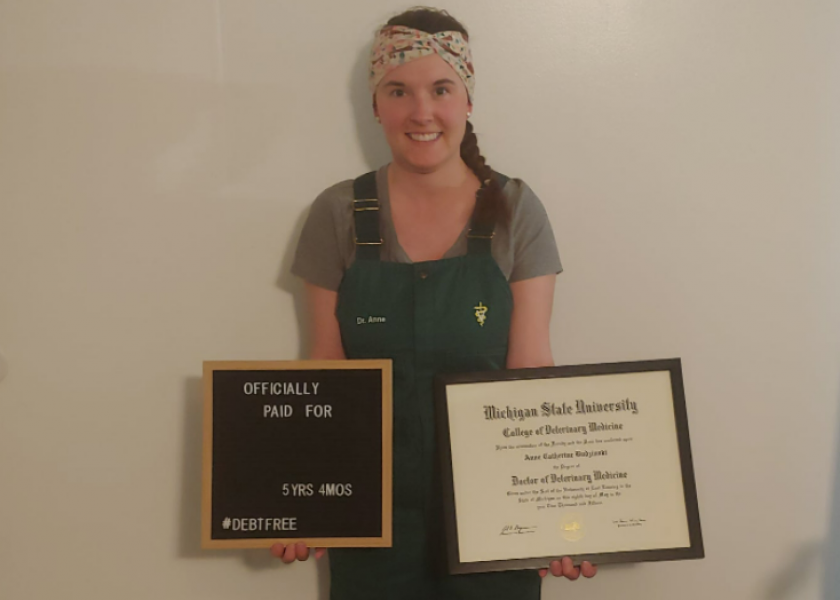From a Mountain of Debt to a Molehill

If you feel like you’re chipping away at a never-ending mountain of veterinary school debt with no end in sight, you’re not alone.
The average veterinary-school debt among borrowers in 2020 was $188,853, according to a survey of fourth-year students. The survey was done shortly before graduation by the American Veterinary Medical Association.
Anne Budzinski was one such student. When she graduated from the Michigan State University veterinary school in 2015, she had accumulated $184,000 in debt from 17 student loans.
But Budzinski didn’t stay stuck in the debt trap. With a detailed plan, time and determination, she determined to be debt-free in 10 years. Surprising even herself, Budzinski reached her goal of being debt-free in only five years, four months.
She says if she can overcome crippling debt, then you can, too.
She spoke on the topic of eliminating debt during the 2022 AABP Recent Graduates Conference.
Here are some highlights from her presentation.
Where to Start?
Debt can be overwhelming for anyone. Start the process of addressing it by knowing your status – what kind of loans you have, the various repayment plans that are available and which ones might work best for you and your situation. Budzinski provided an overview of plans, which you can see at the end of this story*.
For information on federal student loans, she recommends going online to the National Student Loan Data System to get an overview of what you owe.
If you have taken out private loans, however, you’ll need to sort through any online records or existing paperwork you have filed away.
Evaluate your Debt-to-Income Ratio (DIR)
Your DIR equals total debts divided by total income. Knowing this information can help guide you on how to structure your debt payments.
Put together a Financial Plan
You might consider this a monthly budget or even a spending plan. Whatever you decide to call it, have a plan for every dollar that comes into your hands. Assign every dollar to a category, Budzinski recommends. The categories might include:
• Rent/mortgage
• Other debts
• Groceries
• Utilities
• Insurance
• Vehicle
• Emergency Fund
• Retirement
• Recreation
Seek Good Counsel
Check with people who are knowledgeable about finances. Ask if they can recommend an advisor in your area who can help you put together a plan to pay off your debt. If you can’t find someone locally, check with online resources such as Crown Financial or Dave Ramsey and others.
In the process of working on her student debts, Budzinski says she signed up for Ramsey’s program called Financial Peace University, a nine-lesson course that teaches people how to pay off debt quickly, develop a budget and invest for the future.
Financial Setbacks
Budzinski says there were financial bumps along the way to financial freedom. One of the first ones was on her way to a job interview at CalfCare in North Manchester, Ind., when her truck broke down. She ended up buying a new truck, which added more stress to her situation.
“But it worked out, and I got the job, which I love,” she says.
Some Triumphs
During her presentation, Budzinski highlighted some of what she called her victories and triumphs. Here are four:
1. Working overtime – This gave her additional dollars to put toward debt reduction. “The first three years, I signed up for whatever I could to make some extra dollars,” she says.
2. Using the snowball method of debt payment – The process involves paying off the smallest loan you have as quickly as possible. Then, once it’s paid you take those dollars and roll them into paying off the next-smallest debt you owe. The process continues until all your debts are paid in full.
3. Planning fun activities – Budzinski says she and her husband, Anthony, budgeted some dollars each month for fun. They also looked for free concerts to attend, parks where they could hike and cheap meals out (think coupons, buy one and get one deals).
4. Contributing to retirement – “Even if it’s a small amount, try to do this especially if you can get an employer match for the dollars,” she says. “Those are free dollars, so don’t leave them on the table.”
Stay the Course
Budzinski says if you believe you can pay off your debt, you can. Set realistic goals and work your plan.
“It’s a huge weight lifted off my shoulders,” she says. “It’s just so freeing, and we feel like we can do anything now.”
*Here's a quick overview of the most common loan repayment plans and loan forgiveness plans, which Budzinski addressed in her presentation:
Standard or Default Plan
10 years paid in full
120 fixed payments
Graduated or Extended plan
Up to 25 years paid in full
Payments start low and gradually increase over time
Income Based Repayment Plan (IBR)
20 to 25 years of payments
10-15% of discretionary income is minimum monthly payment
Requires income verification annually
Pay as You Earn or Revised Pay as you Earn
Up to 25 years of payments
10% of discretionary income is minimum monthly payment
Requires income verification annually
Repayment Plans with Discretionary Income
Discretionary income: Your taxable income – 150% federal poverty guidelines, which can differ by state.
Calculate 10% to 15% of your discretionary income to figure out minimm monthly payments for income-based repayment plans.
Public Service Loan Forgiveness
120 qualifying payments
Work in an eligible position
Certification forms must be submitted annually.
Loan Assistance Programs
Shortage areas
Employer programs
IBR, Pay as you Earn, Revised Pay as You Earn plan
20-25 years of on-time payments plus income verifications annually
Remainder will be forgiven
Remainder is taxable income = sizable tax to pay on income taxes
Public Service Loan Forgiveness Plan
120 qualifying on time payments + eligibility met + certification forms annually
Remainder will be forgiven
Remainder is tax-free







